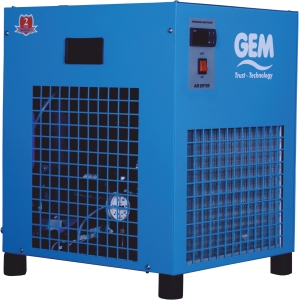
Compressed air dryers fall into four general categories:
- Deliquescent
- Refrigerated
- Desiccant
- Membrane
Types Of Air Dryer
- Deliquescent: Deliquescent air dryers use an absorptive type chemical to provide 20°F to 25°F dew point suppression below the temperature of the compressed air entering the dryer. The moisture in the compressed air reacts with the absorptive material, which degrades to produce a liquid effluent, which is then drained from the dryer. We have to be careful as this effluent is typically corrosive and must be disposed of in accordance with local regulations.
- Refrigerated: Hot, moist air enters the Refrigeration Dryer through an air to air heat exchanger, where the temperature of the inlet air is reduced. This cooled air now passes through a refrigerant to air to air heat exchanger (evaporator), where the temperature of the air is reduced to between 2° to 5°C. the cooling induces condensation and the liquid water is removed in a liquid separator. The dry air now goes out of the dryer through the air to air heat exchange where the temperature of the air is increased to slightly below the incoming air. This is a continuous process.
The limitation of this dryer is that the dew point cannot go below 2°C Pressure dew point , it is ideal for indoor plant air, for operation of pneumatic air tools, control and general instrumentation. - Desiccant: There are several different types of Desiccant Dryers but they all confirm to the same basic concept. A Desiccant Dryer consists of two pressure vessels or towers filled with the Desiccant. The Desiccant in one bed is on stream, drying the air, while the Desiccant in the other tower is being regenerated. The two towers are interlinked with switching valves so that when the Desiccant in the drying tower is saturated, the valve switches the flow into the tower that has just been regenerated. This switching operation is automatic giving continuous drying. With an Adsorption Dryer, very low dew point, down to –40°C or –60°C can be easily achieved. In special application where very dry air is required, only an Adsorption Dryer will do. Specific application areas are-operation of specialized instrumentation, electronic assemblies, pneumatic transportation of chemicals, climatic chambers and cryogenics.
- Membrane: This type of Dryer is relatively new to the market. It was developed using gas separation technology employed to generate nitrogen. The operation is simple. Compressed air, saturated with water vapor, flows into a membrane made up of bundle of hollow tubes. The compressed air “dwells” in the membrane where the water vapor permeates through the tube wall and vents to atmosphere, the dry air continues into the compressed air distribution system.
The typical features of this system are :
- No electricity required
- No refrigeration system
- Dew points to –40°F
- High initial cost
- No moving parts

